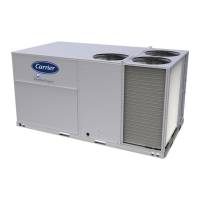26
50LC units may have heat installed as accessories. If the Out-
door Air Temperature (OUTDOOR AIR TEMP) is greater than
the Heating Lockout Temp (HEAT LOCKOUT OAT), all the
heat stages will be locked out (HEAT LOCKOUT).
There are two ways of requesting stages when thermostat con-
trol is enabled, traditional thermostat control or adaptive con-
trol. Traditional thermostat control is used if set for non-adap-
tive thermostat (ADAPTIVE TSTAT = NO). If set for adaptive
thermostat (ADAPTIVE TSTAT = YES), the unit will use
adaptive control for staging. When configured for space sensor
or RAT control (UNIT CONTOL TYPE), the unit will use
adaptive control for staging. With either staging method there
are then two supply air temperature limits, the Maximum SAT
Lower Level (LOWER MAX SAT) the Maximum SAT Upper
Level (UPPER MAX SAT). Any time the supply air tempera-
ture rises above lower level, the heat staging will be limited to
what is currently on and no additional stages will be added un-
til the supply air temperature falls back below the lower level.
If the supply air temperature rises above the upper level, then
heating will be reduced by removing one stage. That stage will
not be added again until the Supply Air Temperature falls be-
low the lower level. If the supply air temperature stays above
the upper level, then another stage will be removed. If the up-
per and lower levels are configured so that they are close to-
gether, the last stage of heat might cycle rapidly, slowed only
by its minimum on and off-time requirements.
Adaptive Control
Stage timers and supply air trend apply when determining the
request for stages. The first request (REQ. HEAT STAGES
=1) comes immediately when starting the staging process. The
Heat Stage Increase Time (HEAT STAGEUP TIME) has to
expire and the Supply-Air Trend (SUPPLY AIR TREND) has
to be above the Heating supply air trend level (HEAT SAT-
TREND LEV) before another stage can be added. Requested
stages will only be allowed to increase as the actual system de-
mand allows (DEMAND). A “LOW HEAT” will only allow
one requested stage and “HIGH HEAT” 2 stages. The request-
ed stages will be reduced if the heating demand is lowered or
dropped completely, or if the supply air falls below the lower
level (LOWER MIN SAT).
Traditional Thermostat Control
Stage timers and supply air trend do not apply when determin-
ing the request for stages. Request staging will follow the ther-
mostat inputs directly. “LOW HEAT” will request one stage.
“HIGH HEAT” will request 2 stages.
HEAT RELAY CONTROL
The heat relay control is responsible for energizing or de-ener-
gizing the heat stage relays and works hand in hand with the
staging control. As the staging control requests stages, the heat
relay control determines what actual heat relays are available
or energized and tries to provide stages for what is requested.
The availability of heat relays depends on the heat installed,
how many stages, and time guards. The Number of Heat Stages
(HEATING STAGE QTY) configuration tells the control how
many heat relays can be used. Heat Stage 1 Timeguard (HEAT
1 TIMEGUARD) and Heat Stage 2 Timeguard (HEAT 2
TIMEGUARD) display the time a respective heat relay has be-
fore it can change state. The available stages at any given time
are displayed as heat 1 available and heat 2 available (HEAT 1
AVAILABLE and HEAT 2 AVAILABLE). The actual heat re-
lays on at any given time are displayed as Actual Heating Stag-
es (ACTVE HEAT STAGE). Heat Stage 1 Relay (HEAT 1 RE-
LAY) and Heat Stage 2 Relay (HEAT 2 RELAY) are displayed
on when the respective relay is energized. There are time
guards to protect from short cycling, Heat Minimum On Time
(HEAT MIN ON) and Heat Minimum Off Time (HEAT MIN
OFF) apply before a heat relay can be turned back on or turned
off.
Integrated Gas Controller (IGC)
The heat staging is determined as described above and the Inte-
grated Gas Controller (IGC) initiates the gas heat module start-
up. The Integrated Gas Controller (IGC) minimum on-time of
1 minute will be followed even if Heat Minimum On Time
(HEAT MIN ON) is lower and during Service Test. If the IGC
temperature limit switch opens within 10 minutes of the end of
the gas heat cycle, the next fan off delay will be extended by
15 seconds. The maximum delay is 3 minutes. Once modified
by the IGC, the fan off delay will not change back to the con-
figured Fan-off Delay, Gas Heat (HEAT FANOFF DELAY)
unless power is reset to the control. A light emitting diode
(LED) is provided on the IGC to indicate status. During normal
operation, the LED is continuously on. See “TROUBLE-
SHOOTING” on page 32 if the LED is off or flashing. The
IGC is located behind the gas section access panel door.
When the control energizes Heat Stage 1 Relay (HEAT 1 RE-
LAY), power is sent to the W terminal on the IGC board. A
check is made to ensure that the rollout switch and limit switch
are closed. The induced-draft motor is then energized, and when
speed is proven with the flue gas pressure switch on the motor,
the ignition activation period begins. The burners will ignite
within 5 seconds. If the burners do not light, there is a 22 second
delay before another 5 second attempt. If the burners still do not
light, this sequence is repeated for 15 minutes. After the 15 min-
utes have elapsed, if the burners still have not lit, heating is
locked out. The control will reset when the request for heat is
temporarily removed. When ignition occurs the IGC board will
continue to monitor the condition of the rollout switch, limit
switches, the flue gas pressure switch, as well as the flame sen-
sor. If the unit is controlled through a room thermostat or space
sensor set for auto-fan, 45 seconds after ignition occurs, the in-
door fan motor will be energized (and the outdoor-air dampers
will open to their minimum position). If for some reason the over
temperature limit opens prior to the start of the indoor fan blow-
er, on the next attempt, the 45 second delay will be shortened to
5 seconds less than the time from initiation of heat to when the
limit tripped. Gas will not be interrupted to the burners and heat-
ing will continue. Once modified, the fan on delay will not
change back to 45 seconds unless power is reset to the control.
When the control energizes Heat Stage 2 Relay (HEAT 2 RE-
LAY), power is supplied to the second stage of the main gas
valve. If both stage 1 and stage 2 of the gas valve close, gas will
be turned off to the main burners.
Supply Air Tempering
Supply Air Tempering control operates the gas or electric heat
to maintain a minimum supply air temperature during condi-
tions where very cold outdoor air causes the supply air tem-
perature to fall below the configured Supply Air Tempering
Setpoint. This occurs during periods where DCV is active and
increasing the amount of outdoor air or in cases where the sys-
tem is operating at very low airflow and the calculated econo-
mizer position has increased to maintain a constant ventilation
rate.
The user can enable/disable Supply Air Tempering.
The following conditions must be true for the supply air tem-
pering algorithm to operate:
• The SA Tempering is set to Yes (OK TO SA TEMPER =
YES)
• The indoor fan is on
• The System Mode is in Vent (Ventilation or Supply Fan
Only) or IAQ Override.
• The Outdoor Air Temperature < Minimum Cooling SAT
48°F.
• Heat type is gas or electric and Number Of Heat Stages > 0
If all the above are true, the SystemVu™ controller will moni-
tor the SAT sensor value and operate the first stage of heat to

